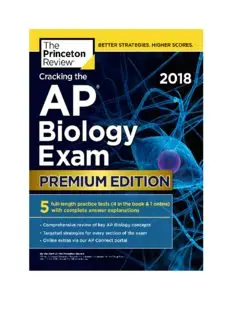
Cracking the AP Biology Exam 20; Premium Edition 2018 - Princeton Review-Penguin Random House PDF
Preview Cracking the AP Biology Exam 20; Premium Edition 2018 - Princeton Review-Penguin Random House
Editorial Rob Franek, Editor-in-Chief Casey Cornelius, VP Content Development Mary Beth Garrick, Director of Production Selena Coppock, Managing Editor Meave Shelton, Senior Editor Colleen Day, Editor Sarah Litt, Editor Aaron Riccio, Editor Orion McBean, Associate Editor Penguin Random House Publishing Team Tom Russell, VP, Publisher Alison Stoltzfus, Publishing Director Jake Eldred, Associate Managing Editor Ellen Reed, Production Manager Suzanne Lee, Designer The Princeton Review 555 W. 18th Street New York, NY 10011 Email: [email protected] Copyright © 2017 by TPR Education IP Holdings, LLC. All rights reserved. Published in the United States by Penguin Random House LLC, New York, and in Canada by Random House of Canada, a division of Penguin Random House Ltd., Toronto. Terms of Service: The Princeton Review Online Companion Tools (“Student Tools”) for retail books are available for only the two most recent editions of that book. Student Tools may be activated only twice per eligible book purchased for two consecutive 12-month periods, for a total of 24 months of access. Activation of Student Tools more than twice per book is in direct violation of these Terms of Service and may result in discontinuation of access to Student Tools Services. Trade Paperback ISBN 9781524710606 Ebook ISBN 9781524710637 AP and Advanced Placement Program are registered trademarks of the College Board, which does not sponsor or endorse this product. The Princeton Review is not affiliated with Princeton University. Editor: Sarah Litt Production Editors: Dallin Law and Jim Melloan Production Artist: Craig Patches Cover art by Sebastian Kaulitzki / Alamy Stock Photo Cover design by Suzanne Lee v4.1 a Acknowledgments The Princeton Review would like to thank Katie Chamberlain, Ph.D, Craig Patches, Jim Melloan, and Dallin Law for their hard work on revisions to this edition. Contents Cover Title Page Copyright Acknowledgments Register Your Book Online! Part I: Using This Book to Improve Your AP Score Preview: Your Knowledge, Your Expectations Your Guide to Using This Book How to Begin Part II: Practice Test 1 Practice Test 1 Practice Test 1: Answers and Explanations Part III: About the AP Biology Exam The Structure of the AP Biology Exam How the AP Biology Exam Is Scored Overview of Content Topics How AP Exams Are Used Other Resources Designing Your Study Plan Part IV: Test-Taking Strategies for the AP Biology Exam Preview 1 How to Approach Multiple-Choice Questions 2 How to Approach Free-Response Questions 3 Using Time Effectively to Maximize Points Reflect Part V: Content Review for the AP Biology Exam 4 Chemistry of Life Elements The Essential Elements of Life Subatomic Particles Compounds Water: The Versatile Molecule The Acid Test Organic Molecules Origins of the Earth Key Terms Chapter 4 Drill 5 Cells Living Things Types of Cells and Organelles Cell Communication In Plants Tropisms Key Terms Chapter 5 Drill 6 Cellular Energetics Bioenergetics Adenosine Triphosphate (ATP) Types of Reactions Gibbs Free Energy Reaction Coupling Photosynthesis The Light Reaction The Light-Independent Reaction Cellular Respiration: The Shorthand Version Aerobic Respiration Chemiosmosis Anaerobic Respiration Key Terms Chapter 6 Drill 7 Molecular Biology DNA: The Blueprint of Life The Molecular Structure of DNA Genome Structure DNA Replication RNA Mutations Biotechnology Key Terms Chapter 7 Drill 8 Cell Reproduction Cell Division The Cell Cycle Interphase: The Growing Phase Mitosis: The Dance of the Chromosomes Haploids Versus Diploids An Overview of Meiosis Key Terms Chapter 8 Drill 9 Heredity Gregor Mendel: The Father of Genetics Mendelian Genetics Beyond Mendelian Genetics Sex-Linked Traits Key Terms Chapter 9 Drill 10 Evolutionary Biology Natural Selection Common Ancestry Genetic Variability Causes of Evolution Species Population Genetics Key Terms Chapter 10 Drill 11 Animal Structure and Function The Structure and Function of Organisms Development Body Systems The Immune System Viruses The Two Immune Responses The Nervous System The Endocrine System Key Terms Chapter 11 Drill 12 Behavior and Ecology Behavior Instinct How Animals Communicate Plant Behavior Ecology Population Ecology Ecological Succession Human Impact on the Environment Key Terms Chapter 12 Drill 13 Quantitative Skills and Biostatistics Summarizing and Presenting Data Types of Data Types of Experiments or Questions Probability Hypothesis Testing Key Terms Chapter 13 Drill 14 Sample Free-Response Questions Section II: Free-Response Scoring Guidelines Sample Essays How to Use the Sample Free-Response Questions Sample Long Free-Response Questions Sample Short Free-Response Questions 15 Laboratory Lab 1: Artificial Selection Lab 2: Mathematical Modeling: Hardy-Weinberg Lab 3: Comparing DNA Sequences to Understand Evolutionary Relationships with BLAST Lab 4: Diffusion and Osmosis Lab 5: Photosynthesis Lab 6: Cellular Respiration Lab 7: Mitosis and Meiosis Lab 8: Biotechnology: Bacterial Transformation Lab 9: Biotechnology: Restriction Enzyme Analysis of DNA
